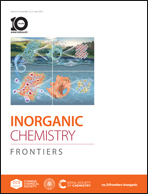Solid-state supercapacitors based on polyoxometalate-based crystalline materials modified with polyaniline†
Abstract
Owing to the rapid advancement of electric energy and energy storage devices, there exists an urgent demand for solid-state supercapacitors that possess high capacitance and safety features. Polyoxometalate (POM)-based complexes are excellent candidates for electrode materials in the construction of solid-state SCs (SCs = supercapacitors), as they are capable of maintaining structural stability during the reversible redox reaction process. However, the poor conductivity of POM-based complexes cannot meet the requisite standards for solid-state SCs. In this study, two new POM-based complexes, H2{Co2Py4(H2O)4[Co2{Co[Mo6O12(OH)3(HPO4)(PO4)3]2}]}·4DMF·10H2O (1) and H6Py2[Mn2{Mn[Mo6O12(OH)3(HPO4)4]2}]·6DMF·4H2O (2) (Py = pyridine) were synthesised and the surface of POM-based electrodes were coated with a conductive polymer (PANI) via electrodeposition, resulting in a marked improvement in the transfer rates of electrolyte ions and electrons. The n@PANI-1 carbon paper electrodes were prepared and symmetrical solid-state capacitors (n@PANI-1-SCs) were assembled (in which n is the number of title complexes); their specific capacity could reach 58.166 mA h g−1 and 35.299 mA h g−1 at a current density of 0.2 A g−1. Moreover, the successful powering of the red LED for a duration of 0.5 min serves as a practical demonstration of the solid-state SC's feasibility. Our new findings may provide some inspiration to develop new solid-state SCs for wearable electronics.

- This article is part of the themed collection: FOCUS: Recent Advance in Supercapacitors


 Please wait while we load your content...
Please wait while we load your content...